
Jan 11, 2019
Athlon Midas TAC 6-24x50mm on Kelbly Atlas Tactical
Table of Contents:
– Background
– Unboxing and Physical Description
– Reticle
– Comparative Optical Evaluation
– Mechanical Testing and Turret Discussion:
– Summary and Conclusion
– Testing Methodology:
Background:
In reviewing both the Athlon Ares BTR 4.5-27x50mm and this Athlon Midas TAC 6-24x50mm this year, I have an unusual situation. Both scopes are from the same brand and, at $849 and $629 street, respectively, I would consider them to be in the same price bracket. This suggests that there will be a lot of overlap in the potential buyers of each scope and begs a great deal of direct comparison as well as an unavoidable degree of re-use of text when discussing things in common such as the background of the company, the near identical manuals, or the very similar adjustment design. My apologies for the overlap, such as the rest of this background section.
Athlon is one of the newest players in the sport optics industry and it turned some heads a few years ago as it seemed to be born, fully formed, with a complete line of scopes at a wide variety of price points. This is because, in some respects, the apple doesn’t fall far from the tree, or runner, depending on your metaphor (I know, stretching it). Athlon was founded by (and is still run by) some Bushnell alums. As such, Athlon had the experience and contacts of a major market player at its start. Its business model also essentially differs little from that of its parent. They are both importers and brands – not manufacturers. As with most importers, they offer a broad selection of product lines and price points sourced from a variety of OEMs.
Where Athlon departs from many of the importers, or at least from its parent, is that it is smaller, more nimble, and flatter in terms of corporate organization. The principal players of Athlon are on the floor at tradeshows talking to customers, industry players, and grumpy writers. This is not really a large or small company thing so much as a philosophic thing. Huge companies, like Kahr or Benchmade for instance, can, and do, have founders on the floor. Much smaller and more bureaucratic companies often do not. This shows in the timeliness of the features Athlon puts in scopes: they have their ear to the ground. My take is that the plan is basically to win on three things: cost, service, and up-to-date feature sets. So far they appear to be mostly delivering on these points. Athlon scopes are generally less costly than other brands coming from the same OEM, they seem to be building a solid reputation for customer service, and their features are up to date with market trends.
Unboxing and Physical Description:
Unboxing the Athlon Midas TAC 6-24x50mm reveals the exact same sparse accessories found with the big brother Ares scope: no caps or covers, just a lens cloth, battery, manual, and invitation for the customer to review the product online. I think I’ll do that.
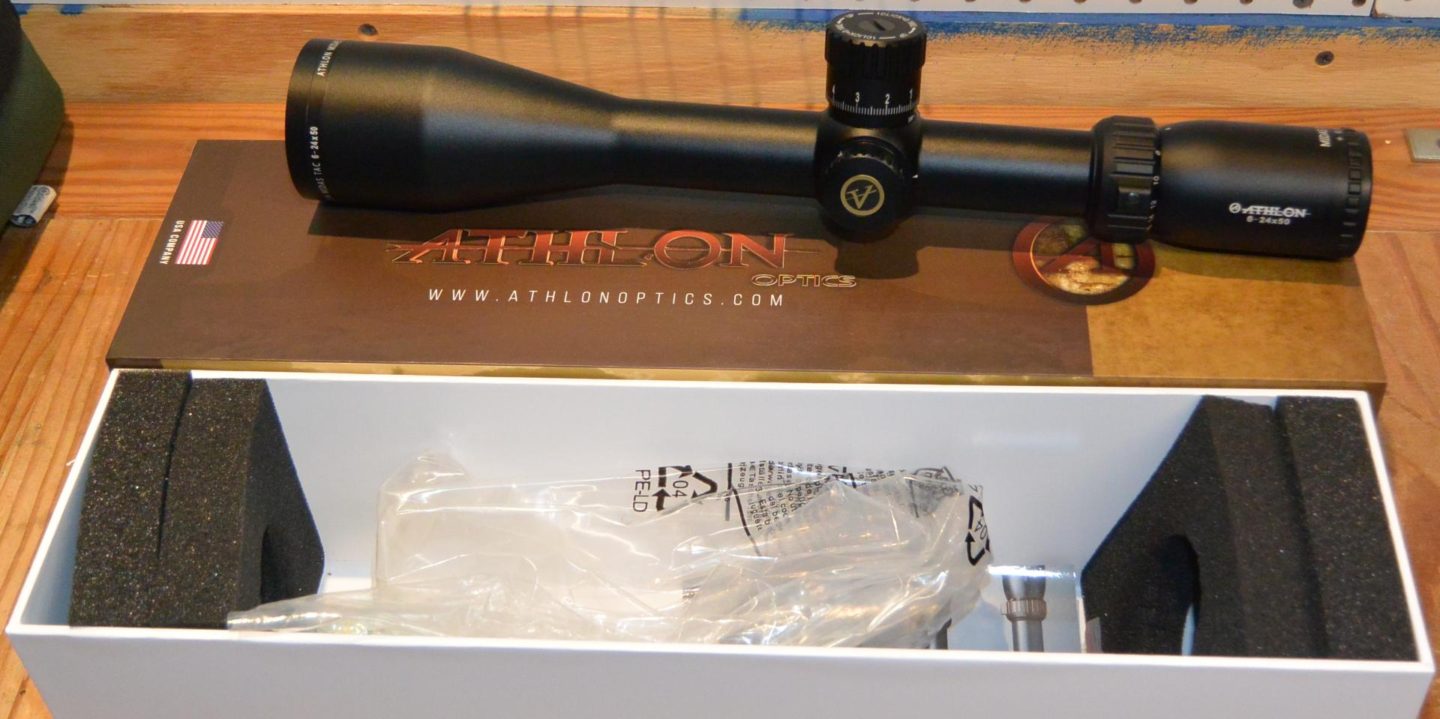
The scope itself is on the smaller side for this magnification range. It features a mid size 50mm objective and is a little longer than the Ares at 14.6″, but slightly lighter at 26.3oz. I am a fan of smaller objective, lighter weight optics. I have the general opinion that traditional objective sizes have never adjusted to the incredible light transmission gains that current generation lens coatings have made possible and this has left many scope makers manufacturing huge, heavy, scopes that gain little additional low light capabilities for all that added weight.
The Midas features a large uncapped 10 mil per turn zero stop elevation adjustment. The design and appearance of the adjustment is nearly identical to that of the Ares though the Midas knob does not include the extra O-ring that the Ares has. The resulting feel is similar to the Ares with the ring removed though the Midas is a bit stiffer. Specifically, it has a little higher ratio of click force / rotation force between clicks. This makes it a little harder to rotate just one click at a time without going over. I would not characterize it as too difficult a scope in this regard, but you are going to occasionally over-rotate with it. I have a slight overall feel preference for the Ares elevation adjustment. I would characterize the Midas as having an average elevation click stiffness with the Ares on the squishier side. Both have a feel I would characterize as fine but neither excellent. These differences between two scopes’ adjustment feel on exceptionally similar elevation knobs serves to highlight just how touchy a thing the adjustment of feel on the clicks of a scope can be.
In a departure from the Ares, the Midas has a smaller capped windage knob. This knob is a 10 mils per turn knob that is marked 1-5 in each direction. It has good feel and is a nice compromise between a hunting design and a tactical design. That is to say, you could really use it either way and be pleased. The power ring and euro style diopter on the Midas are on the looser side of average with a parallax knob I would classify as perfect.
Looking at the features of the Midas TAC elevation knob specifically, it is 10 mil per turn and features both a zero stop system that is a little different from what I have seen before and markings that can be repositioned. Repositioning the markings is done in a common way. They are located on an outer sleeve that pops off and can be repositioned after removal of a screw. This sleeve is toothed with enough teeth that its markings will properly line up with the actual detents instead of landing between as some others have done. The zero stop system is one that the Midas TAC shares with the Ares BTR but I have not seen on other optics – I am embarrassed to admit that I did not even notice that these scopes had one until halfway through the Ares review. As is common, the whole elevation knob on the Midas screws up and down as the adjustment it rotated. This attribute forms the basis of both the zero stop and the simple scribed turn indicator. The zero stop consists of a brass disc they refer to as the “zero stop locking plate” located under the removable outer adjustment sleeve. This disc can be repositioned using three set screws. So, basically, you zero the scope, remove the outer sleeve, loosen the set screws, and move the disc so that it is lying flat on the saddle with its stop protrusion immediately to the right of the stop protrusion on the scope saddle. You then gently tighten the set screws and replace the sleeve and its screw with the proper alignment of the zero. This zero stop is very inexpensive to make in addition to being quite functional. It also has the same advantage as most plunger style systems in that you can set it independently of the markings to give you a few tenths of adjustment below the zero if you want. It is a well designed system and I’m a fan.
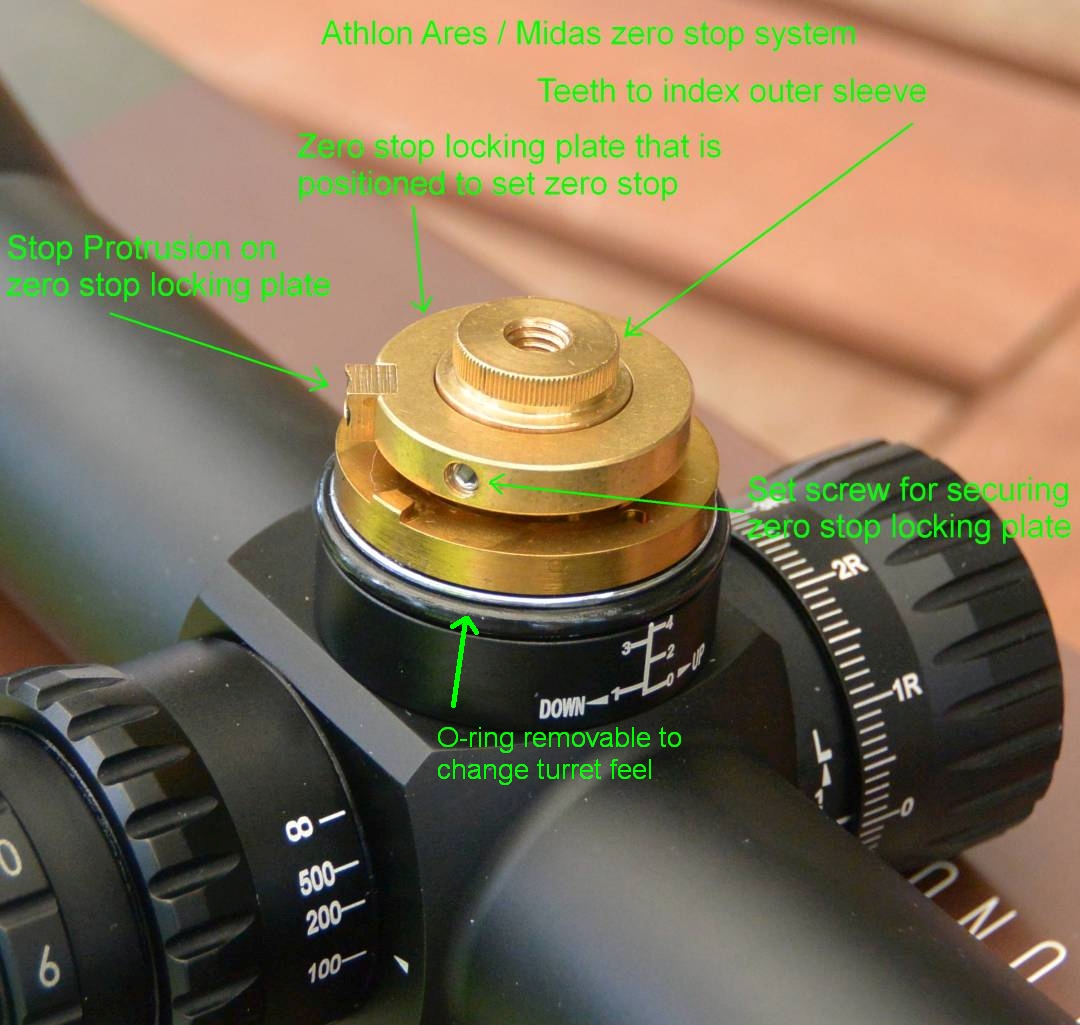
The manual included with the Midas scope is the same mixed bag as the Ares and varies little in its text. It includes pretty good sections on focusing, setting eye relief, bore sighting, zeroing (although it mistakenly refers to the “zero stop locking plate” as black when it is actually brass) and a lesser section on mounting. It also has nice dimensioned diagrams of the reticle. There is some lack of clarity in the manual regarding if Athlon’s MOA based scopes are calibrated to true MOA (TMOA) which is 1.047″ @ 100 yds or shooters’ MOA / inches per hundred yards (SMOA / IPHY) which is 1.0″ @ 100 yds. This is very important as 4.7% error is a lot of error when making long distance calculations. Upon speaking with the guys at Athlon, I found that their adjustments and reticles are calibrated in TMOA. The manual section on troubleshooting tips for accuracy is the most problematic section as it has some poor enough advice in it that I felt the need to write a whole paragraph about the manual. The section advises the shooter to “use a bench rest or sandbag to support the barrel and stock”. Force on the barrel deflects the barrel, causing shots to stray and should be avoided – not encouraged – when seeking to shoot with accuracy. Support of the barrel with sandbags is actually often the cause of inaccuracy and not a solution for it. The manual also says to make sure there is “no excessive grease inside of the barrel”. This suggests to me that there might be a good reason to have a proper amount of grease in the barrel and a novice shooter might then, in error, apply grease to such. Though grease is sometimes used in a barrel for long term storage, there should never be any grease in a barrel when you are shooting. Grease in a barrel can not only cause inaccuracies, but can also cause dangerous and/or unbalanced pressures in a barrel. Grease does not protect a barrel from wear either, as wear is overwhelmingly a product of erosion in the throat of a barrel from powder burning there and not a product of friction with the bullet over the length of the barrel.
Reticle:
The Athlon Midas TAC 6-24x50mm is available in two mil reticle options, the APRS2 and APRS3, as well as one MOA option, the APLR4. The two mil options are very similar to one another with the APRS3 being comprised of the APRS2 plus a Christmas tree section graduated in one mil increments vertically and .2 mil increments horizontally. The APRS2 is a typical mil hash reticle featuring a floating dot center and .2 mil increments horizontally out to 6 mils then .5 mil increments after that out to 9 mils, at which point there is just a thick crosshairs. Vertically, the reticle is graduated in .2 mil increments for just one mil. At that point, the top half is graduated in .5 mil increments out to 9 mils and then it becomes a thick crosshairs, while the bottom half is graduated in .5 mil increments out to 7 mils where it goes back to .2 mil increments until 10 mils, at which point it becomes a thick crosshairs. While there is probably some rationale for the alternating use of a .2 mil graduation system and a .5 mil one, that is not fully explained anywhere and I likely wouldn’t agree with it over the consistency of sticking with the .2 mil increments throughout, though it probably doesn’t matter a whole heck of a lot anyway. For what it’s worth, I think .2 mil graduations are a pretty good choice on a scope of this power range. Both vertical and horizontal crosshairs are numbered every 2 mils and are on the thinner than average side when it comes to line thickness. Generally, I think users will find both the APRS2 and APRS 3 reticles good choices with the user’s preference regarding a Christmas tree section the dividing factor on choice.
When tested, the reticle showed a very slight cant of ~.5 degrees counter-clockwise relative to the adjustments. This is not an amount of deviation I would be concerned about.
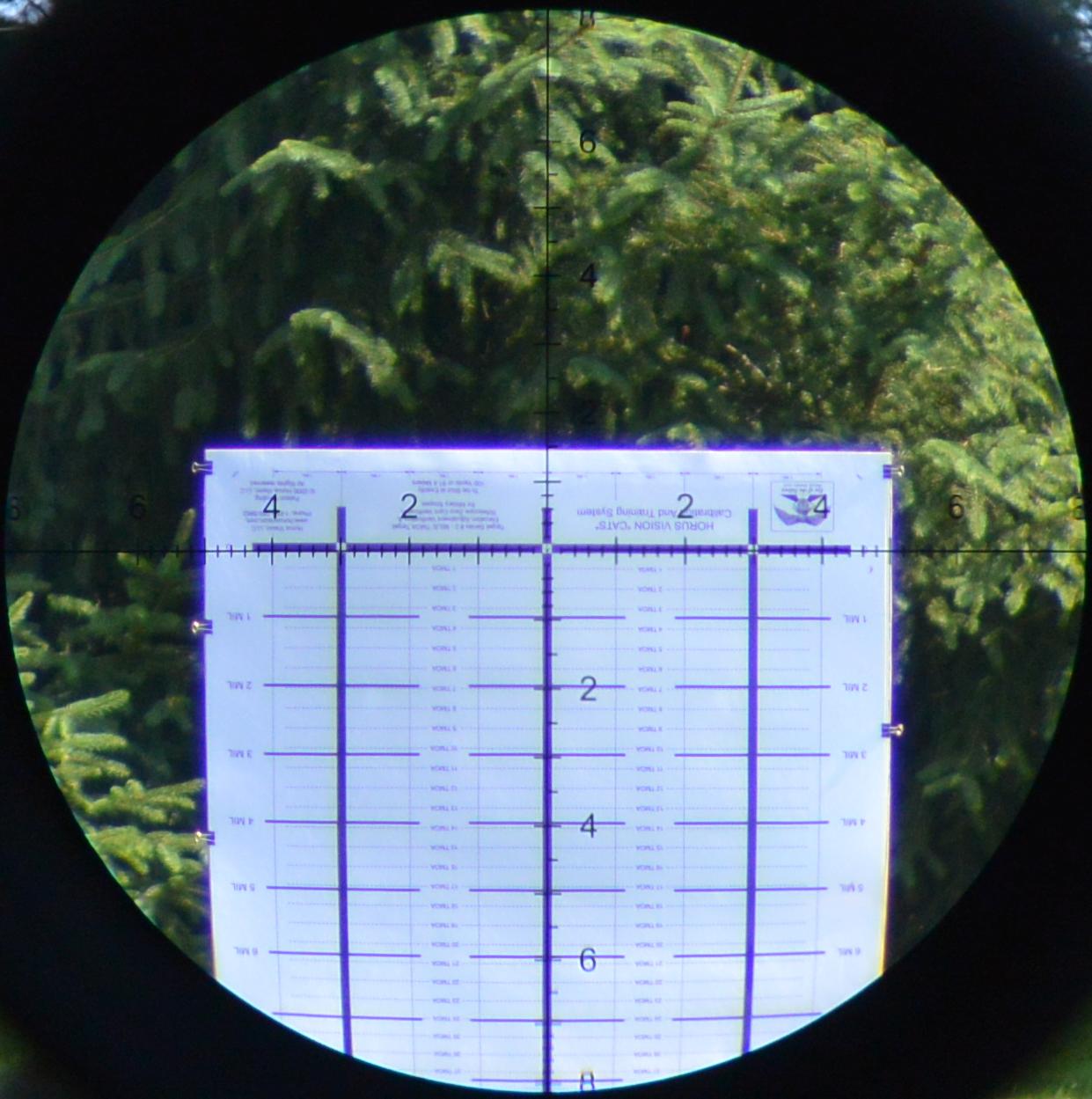
Comparative Optical Evaluation:
For optical comparisons to this Athlon Midas TAC 6-24x50mm, I had the other scopes in this series of sub $1K FFP mil/mil precision rifle scope review, the Athlon Ares BTR 4.5-27×50 FFP IR Mil and Sightron SIIISS624x50LRFFP/MH, as well as two that have been used as comparisons by me in previous reviews for context, the Leupold Mk 6 3-18×44 and my old (and now discontinued) Zeiss conquest 4.5-14×44. All of these scopes were lined up together on a five slot adjustable v-block and evaluated using the procedure outlined in the methodology section at the end of this review. This same methodology is used on all long range scope evaluations and has been for several years now.
I have never before had a set of five scopes with such generally close optical performance. Usually, scopes somewhat sort themselves into performance tiers with higher tier scopes being better than lower tier scopes in pretty much all characteristics. That was not even remotely the case with this lineup. No scope was always first or last when evaluating particular performance parameters and the order of the scopes’ rankings changed with pretty much every particular parameter being evaluated. That being said, the Midas was, on balance, on the lower side of average for the group and was bested by its Athlon Ares stablemate in almost all respects. The best aspects of optical performance for the Midas were its larger than group average field of view and better than average contrast. Its weakest points were eyebox, chromatic aberration, and pincushion / barrel distortion. None of these performance aspects were what I would consider problematic, but they were areas where it lagged behind the comparison scopes and, most importantly, its sibling. The Midas scope performed closer to middle of the pack in resolution, stray light handling, and depth of field. Edge to edge clarity was excellent on all the scopes tested and no scope displayed any tunneling.
It is worth noting here that the Midas is the least expensive scope in this lineup by a significant margin. In that respect, bully to the Midas for keeping up and even beating the average in a few aspects. That is not how I feel about it overall though. Being a 6-24x scope, the Midas is much simpler to do well than its 4.5-27x Ares sibling. At the same design and build quality, the Midas would look much better than the Ares because 6x erector ratios are much, much harder to do well than 4x ones. That is not the case however. The Ares is optically better is almost all respects. It has a truly excellent performance at the price the Ares puts out and merely adequate performance at the price the Midas provides. It’s hard to feel really good about the Midas optical performance next to the Ares.
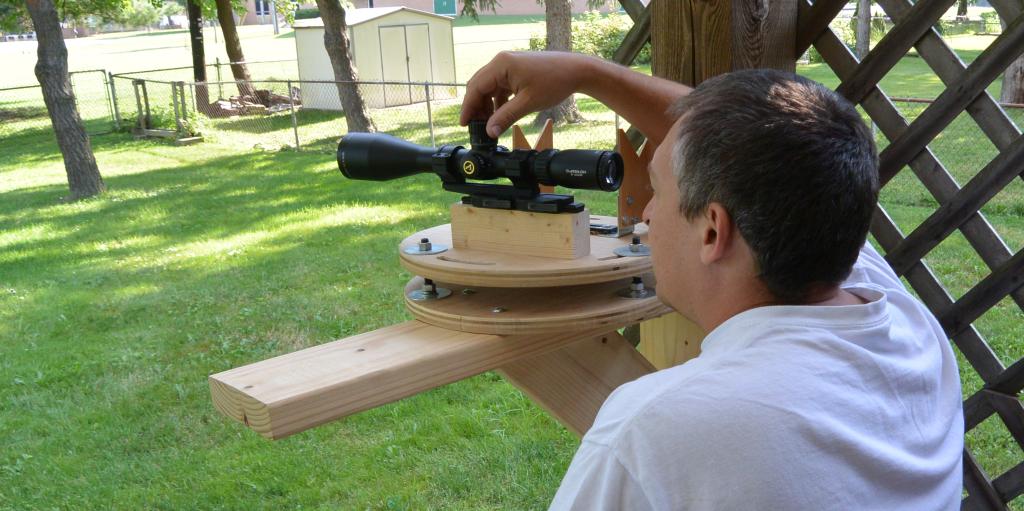
Mechanical Testing and Turret Discussion:
As mentioned in the unboxing section, the Athlon Midas TAC 6-24x50mm sports a very feature rich 10 mil per turn zero stop elevation knob where the zero stop and zero are set independently, allowing you to set whatever amount of turn below the zero before the stop that you desire. The windage knob is also 10 mils per turn, though with a lower profile and capped construction. It also lacks a stop and is marked out to 5 mil left and right instead of continuously. Testing the accuracy of these adjustments was done in accordance with the methodology section detailed at the end of this review. This methodology was followed on all the scopes this year and has been in use for a few years now.
In testing, the adjustments tracked monotonously perfectly in all respects. The scope adjusted up from optical center 14.3 mils with no deviation and then perfectly down 8.5 mils. This is not the full range of travel down but rather the travel with the zero stop flush to the center post. There is a little room internally for the zero stop to protrude above the post with no problems. I show a maximum of 12.4 mils down on my example in this configuration though I did not test the tracking out to that point. You could also remove the stop feature entirely and get even more travel. I show a max of 14.1 mils on my example. These numbers would suggest a 30 MOA base should not cause a problem and that some users might be able to do a 40 MOA and still have a 100yd zero though that will depend a lot on the rifle since there is variance in all rifles between the centerline of the rail and that of the bore.
Tracking on both adjustments was repeatable and the scope returned to zero with no problems. The windage and elevation were also properly independent. No zero shift was affected by power change, parallax change, or diopter change.
You don’t get any better than zero deviation so a big win for that. Getting adjustments to exactly match the correct magnitude is one of the most difficult aspects of scope manufacture. As such, most scopes show deviation to some degree measurable with my equipment. The average deviation for precision rifle scopes, based on my past tests, is about 1%.
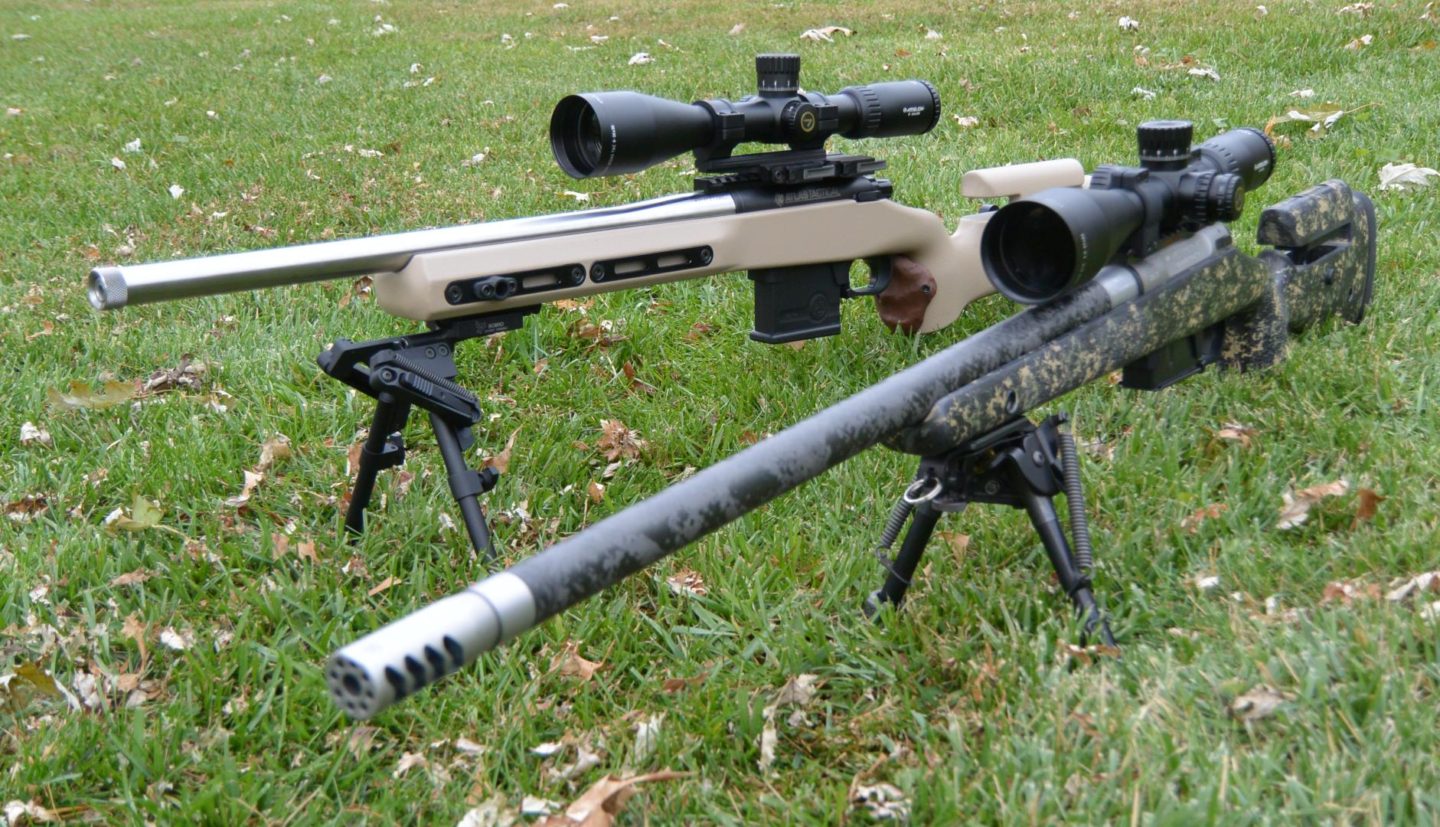
Summary and Conclusion:
The Athlon Midas TAC 6-24x50mm is a lot of scope with a lot of features for the $630 street that it goes for. The thing is that its sister scope, the Athlon Ares BTR 4.5-27x50mm is a even more scope at its $850 price. This is emotionally hard for me. I understand intellectually that the 35% more that the Ares costs is a very meaningful difference and that the Midas might itself be a budget stretch that represents a new world of possibilities since you are talking about a scope with real long range capabilities in a price range otherwise full of set and forget limited range scopes. The Midas will mean that previously inaccessible game at 400yds is very doable. That could be quality meat for months for a family. It is hard, as an optics geek (even a not so well-heeled optics geek) to connect with that though. It is much easier for me to be really impressed that Athlon managed to get better optical performance out of the Ares while also cramming in a 6x magnification ratio and landing it at the very low price of $850. Sure, a 6x vs 4x magnification ratio might not really translate into much more utility for you, the added illumination on the Ares is no more utility to almost anybody, and the Ares is only a little optically better, but aren’t you moved by how much more lit up some optics geek got about it?
Here is Your Pro and Con Breakdown:
Pros:
– Optics are significantly better than average at the price
– Tracked perfectly
– Very low price for a full featured FFP Mil/Mil zero stop scope
– Properly sized reticle with very little cant
– Very simple effective zero stop that lets you chose travel below zero
– Lightweight, 26.3oz
– Smaller 50mm objective I prefer
– Full 10 mil/turn knobs
– Good adjustment range, 25mil
– Reticle design in line with current trends
– Good warranty
Cons:
– It’s hard not to recommend its sister scope, the Ares BTR 4.5-27×50, over it for better optics, more features, and a much larger 6x magnification ratio
– Basically no extras like scope caps, sunshade, or bra
– Athlon is a new company with a good, though very short, track record
– Manual has some advice that may lead a novice astray


